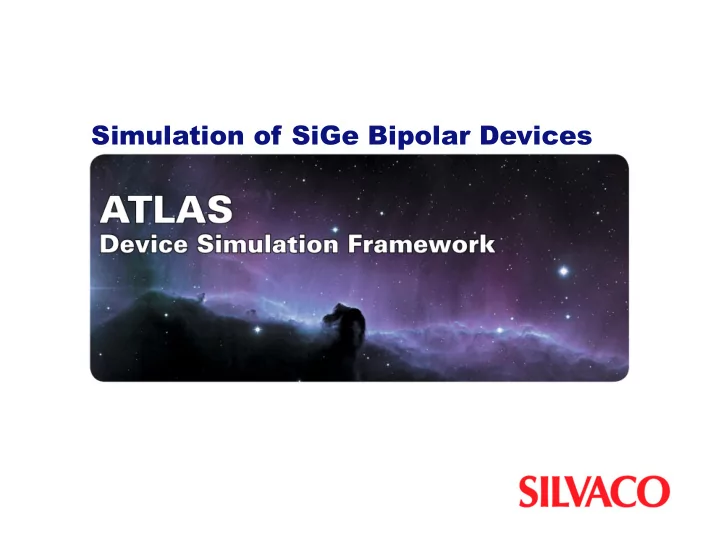

Simulation of SiGe Bipolar Devices
Introduction Construction of SiGe HBT using ATHENA Mesh Refinement using DevEdit Device Characterization using ATLAS Conclusion - 2 - Simulation of SiGe Bipolar Devices
Construction of SiGe HBT using ATHENA Layout Structure cross-section Surface Details Doping Profiles Mesh - 3 - Simulation of SiGe Bipolar Devices
SiGe HBT Layout - 4 - Simulation of SiGe Bipolar Devices
SiGe HBT Generated by ATHENA - 5 - Simulation of SiGe Bipolar Devices
SiGe HBT - 6 - Simulation of SiGe Bipolar Devices
SiGe HBT Doping - 7 - Simulation of SiGe Bipolar Devices
Vertical Doping Profile Under the Base Electrode - 8 - Simulation of SiGe Bipolar Devices
ATHENA Generated Mesh - 9 - Simulation of SiGe Bipolar Devices
Mesh Refinement Using DevEdit ATHENA process mesh is not Ideal for device simulation using ATLAS DevEdit can provide the correct Interface - 10 - Simulation of SiGe Bipolar Devices
Mesh Refinement Using DevEdit - 11 - Simulation of SiGe Bipolar Devices
Refined Mesh Generated by DevEdit - 12 - Simulation of SiGe Bipolar Devices
Device Characterization Using ATLAS Gummel plot Small signal frequency response Energy bands Example deck - 13 - Simulation of SiGe Bipolar Devices
SiGe HBT Gummel Plot and Gain Curve - 14 - Simulation of SiGe Bipolar Devices
Capacitance Versus Frequency - 15 - Simulation of SiGe Bipolar Devices
Electron Concentration and Energy Band Diagram - 16 - Simulation of SiGe Bipolar Devices
SiGe HBT Worked Example go athena # SiGe HBT simulation (c) Silvaco International 2004 # # Establish initial grid and substrate material # line x location=0.0 spacing=0.1 line x location=0.5 spacing=0.05 line x location=0.7 spacing=0.05 line x location=1.2 spacing=0.1 line x location=2.2 spacing=0.25 # line y location=0.0 spacing=0.01 line y location=0.1 spacing=0.02 line y location=0.5 spacing=0.05 line y location=0.8 spacing=0.15 # - 17 - Simulation of SiGe Bipolar Devices
SiGe HBT Worked Example (con’t) init silicon c.phos=2e16 # structure outf=tmpr1.str # init inf=tmpr1.str flip.y implant phos energy=60 dose=3e15 # diffuse time=5 temp=1000 struct outf=temp init inf=temp flip.y # # Deposit Silicon germanium with composition fraction 0.2 for base # deposit sige thick=.1 divis=12 ydy=0.05 dy=0.02 c.frac=0.2 c.boron=1e15 # - 18 - Simulation of SiGe Bipolar Devices
SiGe HBT Worked Example (con’t) moments i.boron sige dose=1e13 energy=10 range=0.033 std.dev=0.018 gamma=0.04 kurt=3.2 implant boron energy=10 dose=1.0e13 # # Deposit silicon for the emitter deposit silicon thick=0.2 divis=10 ydy=0.08 dy=0.04 c.phos=1.e15 # moments i.boron sige dose=3e14 energy=12 range=0.033 std.dev=0.018 gamma=0.04 kurt=3.2 implant boron energy=12 dose=3e14 # diffuse time=0.5 temp=920 # # Mask and implant the emitter - 19 - Simulation of SiGe Bipolar Devices
SiGe HBT Worked Example (con’t) deposit photo thick=.5 divis=5 etch photo left p1.x=0.5 # moments i.phos sige dose=6e15 energy=38 range=0.0534 std.dev=0.0236 gamma=0.401 kurt=3.1630 implant phos energy=38 dose=6e15#diffuse time=5 temp=920strip # # Deposit and pattern the contact metal deposit aluminum thick=.05 etch aluminum start x=0.5 y=10. etch cont x=0.5 y=-10. etch cont x=1.2 y=-10. etch done x=1.2 y=10. # - 20 - Simulation of SiGe Bipolar Devices
SiGe HBT Worked Example (con’t) # Define the electrodes electrode name=emitter x=0.0 electrode name=base x=2.0 electrode name=collector backside # # Define impurity characteristics in each material impurity i.boron acceptor sige impurity i.phos donor sige # structure outfile=example.str go atlas # # Material parameter and model specification # - 21 - Simulation of SiGe Bipolar Devices
SiGe HBT Worked Example (con’t) material material=Si taun0=1e-7 taup0=1e-7 material material=SiGe taun0=1.e-8 taup0=1.e-8 model bgn consrh auger fldmob conmob # # Bias collector to 2 volts output con.band val.band method gummel newton solve local vcollector=2.0 # # Bias base for Gummel plot output con.band val.band method newton trap solve vbase=0.01 solve vbase=0.05 - 22 - Simulation of SiGe Bipolar Devices
SiGe HBT Worked Example (con’t) solve vbase=0.2 log outfile=ex_gum.log master solve vbase=0.3 vstep=0.05 name=base vfinal=0.9 save outfile=ex_str.str - 23 - Simulation of SiGe Bipolar Devices
Worked Example HBT - 24 - Simulation of SiGe Bipolar Devices
Doping Concentration - 25 - Simulation of SiGe Bipolar Devices
Gummel Plot and Gain Curve - 26 - Simulation of SiGe Bipolar Devices
Electrostatic Potential and Energy Band Diagram - 27 - Simulation of SiGe Bipolar Devices
Conclusion ATHENA provides a complete simulation of SiGe processing for HBT devices DevEdit provides the necessary bridge from process simulations to device characterization ATLAS provides accurate characterization of device performance - 28 - Simulation of SiGe Bipolar Devices
Recommend
More recommend